Roses are among our most treasured garden plants (Figure 1). Throughout history their elegant, symbolic flowers have occupied a special place in the hearts and minds of people everywhere. However, proper care after planting is essential to develop plants into beautiful, productive specimens.
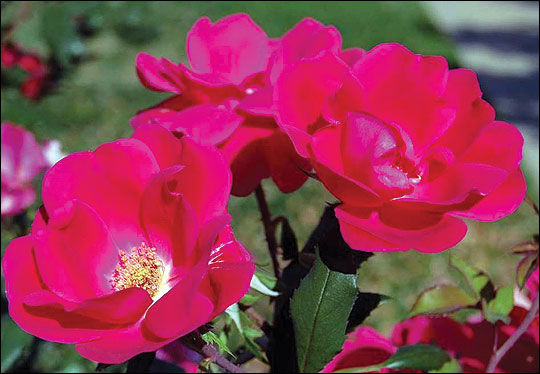 Figure 1
Figure 1
'Knockout' rose has become very popular with gardeners because of its disease resistance and free-blooming nature.
Watering
Roses must have good drainage and perform best when they have abundant water. The soil around the roots should always be moist but never saturated. Apply water when the top 1 to 2 inches of soil is dry.
Thorough, deep watering is important. Never give light surface applications. Water should be applied slowly enough to prevent surface runoff and long enough to ensure deep soil penetration. At each watering, soil should be soaked to a depth of at least 1 foot.
There are many methods of watering roses. One of the best is drip irrigation, which applies water very slowly at the base of the plant. Soaker hoses tend to do the same but at times wet the lower leaves, depending on water pressure.
Overhead sprinkling is usually the most convenient method of watering, but it promotes spread of diseases such as black spot by wetting the foliage. If overhead sprinkling is practiced, water in the morning or early in the afternoon so the foliage will be thoroughly dry by evening.
Also, overhead sprinkling washes insecticides and fungicides from the foliage. Therefore, dusts should be applied after watering while the foliage is still damp. Sprays should be applied the next day or after the foliage has dried from the watering.
Mulching
Roses benefit from organic mulch placed over the bed or around individual plants. Make the mulch 2 to 3 inches deep. This depth helps control weeds, keeps the roots cool and soil moist, and reduces watering frequency. Don't place the mulch against the stem of the plant. Instead, keep it about 6 inches away from the base of the plant. This space forms a basin to aid in watering.
Fertilizing
Roses are heavy feeders and, once established, need additional fertilization for best performance. In soil properly prepared for planting, maintenance fertilization will be relatively simple. Use either inorganic or organic fertilizers, or a combination, which often provides best results. Inorganics are quicker acting and more concentrated. Organics are more slowly available and contribute fertility over a longer period. Some contribute humus to the soil.
Inorganic materials
Complete inorganic fertilizers are convenient and easy to use. Generally, roses need a higher percentage of phosphorus (the second number on the bag) than nitrogen and potassium (first and third numbers, respectively). Therefore, analyses such as 5-10-5, 4-8-4, or 4-12-4 are good maintenance fertilization for roses. If you are unable to find fertilizers with these or similar analyses, a 1-1-1 ratio such as 8-8-8 or 12-12-12 may be used.
Generally, when a complete fertilizer is used, about 3 pounds should be applied per 100 square feet or 1 heaping tablespoon per plant. Spread the fertilizer evenly around the plants, and lightly work it into the soil surface. Apply the fertilizer before a rain or before watering.
Make the first fertilizer application in spring after danger of severe freeze is past, and additional applications about every six weeks. Don't fertilize after July; reducing fertility in the fall helps harden the plants for winter.
Organic materials
Manure is excellent as a mulch or for incorporating into the soil. Only aged manure should be used, as there is chance of burn from fresh manure. All types add organic matter and are good soil builders. Manures should be spread on the surface to a depth of 2 to 3 inches.
Liquid fish fertilizers supply a quickly available source of nitrogen as well as some other elements. Follow the manufacturer's directions on the label when applying. The strong, fishy odor of these materials may be objectionable.
Bone meal is a valuable source of slow-acting and long-lasting phosphorus. It should be mixed into the soil because it does not move down readily with watering. Use about 1 heaping tablespoon per plant.
Blood meal is a source of organic nitrogen. Use it carefully because an excess can burn roots. Generally, 1 level tablespoon applied around each plant is adequate.
Lime
Roses prefer a soil pH slightly acid — from 5.5 to 6.5. When the pH needs to be raised, ground limestone is the best material to use because it supplies the plant with calcium. Ideally, a soil test should be taken and necessary amounts of limestone applied before roses are planted. If this was not done, gradually increase the pH by applying 2 tablespoons of ground limestone per plant per year.
On those rare occasions when soil pH needs to be lowered, ground sulfur is recommended. Used at the rate of 8 ounces per 100 square feet, it will lower soil pH between 0.5 and 1.0 units.
Pruning
Cutting flowers.
Every time rose blooms are removed, plants are partially pruned. If plants are new or weak, cut the flower stems to leave as much foliage on the plant as possible. It is usually best not to cut flowers from a new planting until fall of the first season.
Even after plants are well established, never cut stems longer than needed. Leave at least two leaves on each stem (Figure 2). Weak stems may be cut shorter to force out lower, stronger growth. Thick vigorous stems may be cut higher.
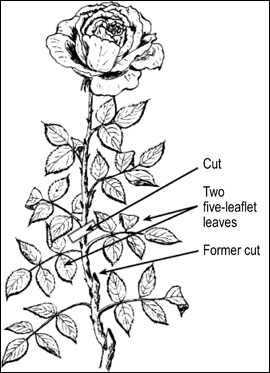 Figure 2
Figure 2
When cutting roses, allow at least two, five-leaflet leaves to remain on each shoot.
 Figure 3
Figure 3
Pruning hybrid teas, floribunda, or grandiflora roses.
Seasonal pruning
Climate often determines the best pruning time. Roses normally need a light fall pruning and a more thorough spring pruning.
Keep these factors in mind when pruning any roses:
- Remove all dead wood.
- Remove wood that is diseased, broken or injured in any way.
- Remove any basal shoots on budded plants that are different from the main plant.
- Remove branches that cross through the center of the plant or rub on other branches.
- Prune to improve the shape of the plant.
- Prune to provide good air movement through and around the plant.
- Make cuts slightly above a strong bud that faces the outside of the plant.
- Make all cuts clean and smooth by using sharp, disinfected pruning shears or knives.
Hybrid teas, floribundas, and grandifloras
Where winter temperatures may be damaging, it is best not to prune severely in fall. Take off only tops of canes with branching growth that tends to catch winds. Pruning in spring means a more thorough reduction in size. Normally, prune stems to about half the length they grew the previous season (Figure 3). However, do not cut back hybrid teas, floribundas and related types to less than 18 inches unless winter cold has killed them lower.
 Figure 4
Figure 4
Prune vigorous climbers and ramblers after flowering.
Climbers (ramblers)
Pruning climbers differs slightly from pruning hybrid teas. Very vigorous types, known as ramblers, should be pruned in late spring immediately after flowering (Figure 4). All old canes that have flowered should be removed close to the base of the plant. This practice will force out young vigorous canes for bloom next year.
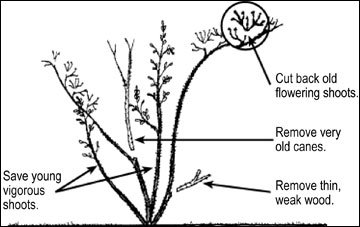 Figure 5
Figure 5
Prune repeat blooming climbers while dormant.
Climbing hybrid teas and other large-flowered, everblooming climbers
These roses don't need severe pruning. Many should have little or no pruning the first two to three years. Prune only to shape the plants and remove dead canes. Prune climbers late in the dormant period just as buds are breaking (Figure 5). Maintain two or three major canes. As new, vigorous canes develop from the base, allow them to remain and grow. After they develop, remove any old canes close to ground level to maintain the basic two or three vigorous basal canes. The best blooms of climbing hybrid teas are produced on short branches coming from 2- to 3-year-old wood. Allow these branches to remain, and cut them back to two or three vigorous buds per shoot. In summer, remove blooms as soon as they have faded.
 Figure 6
Figure 6
Protect roses in winter with a mound of soil 10 to 12 inches deep. Tender varieties may benefit from layer of straw or evergreens over soil mound.
"Old garden" and shrub roses
Old garden rose species, such as the Damask rose, and shrub roses represent many different growth habits. Proper pruning results from becoming familiar with the growth habit of a particular type. In general, pruning of these types is little more than cutting back canes to shape the plants, removing dead flowers, or removing old poor-growing canes as new vigorous ones develop.
Winter protection
Many old garden, shrub and ramblers are reliably hardy and need little or no winter protection. The hybrid tea floribunda, grandiflora and climbing hybrid tea roses may be injured during severe winters. Some protection is necessary to ensure their survival. Planting in protected locations reduces the need for special winter protection.
The best form of winter protection is to mound up each plant at its base with loose, friable (crumbly) soil that drains well (Figure 6). This soil should be mounded up around the base of the canes to a height of 10 to 12 inches. Don't scrape up soil from between the plants as roots may be injured. Bring soil from another spot in the garden.
Loose compost or aged sawdust may be used in place of soil for winter protection. Don't use leaves, grass clippings, manure or materials that would remain wet or rot around the canes and promote disease. Evergreen branches or straw placed over the mounds will give additional protection.
Proper summer care is an added means of winter protection. A vigorous bush is much more able to stand cold than a weak one. Some of the more tender climbers may need to have their branches laid on the soil and covered with soil, straw or evergreen branches to keep them in good condition through the winter so they will flower next year.
Carefully remove the covering in spring after danger of severe freeze is over. Don't be too quick to remove it as the soft, tender shoots that develop beneath it are easily killed by light freeze. Keep some straw or mulch material handy to cover plants in case of late frost.
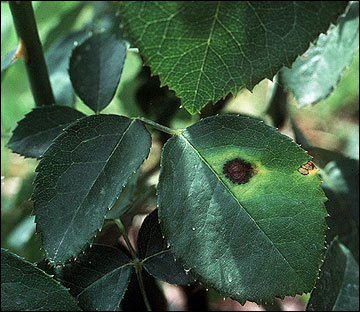 Figure 7
Figure 7
When cutting roses, allow at least two, five-leaflet leaves to remain on each shoot.
Pests
There are many pests of roses; a few are especially serious. Most can be controlled with pesticides available from garden supply stores or nurseries. The key to good control is identifying the problem. Successful control requires good sanitation and a regular spray program, using the materials as directed by the manufacturer. Thorough spray coverage of both the upper and lower leaf surfaces is important. Liquid sprays are generally more effective than dusts, especially for disease control. Some of the most common rose problems are described in the next sections.
Diseases
Black spot
As the name implies, black spots with fringed margins appear on the leaves (Figure 7). Spots enlarge as they develop, until the entire leaf yellows and finally drops off. This defoliation, if severe, will weaken the plant, reduce flowering, and make the plant more subject to winter damage. Black spot is caused by a fungus that is most severe in wet seasons, in wet climates, and on plants in locations where there is little air movement. A wet leaf surface is essential for its spread.
Plant roses where air movement is good and where the sun hits the plant early in the morning and quickly dries foliage. On the more susceptible varieties, a regular spray program with a fungicide labeled for black spot is important. Frequent spraying may be necessary during wet periods. Spray shortly after rains whenever possible.
Cleanliness around plants is also important because the fungus is carried over winter by dead leaves on the ground and infections on the stem. Rains and splashing water spread spores from old leaves or stems. Remove infected leaves as soon as you see black spots developing. This practice is especially helpful in early spring when the disease is just getting started.
Powdery mildew
Mildew is more common to some varieties and types of roses than others. Ramblers are particularly susceptible to this disease. Leaves develop a grayish powdery growth (Figure 8). Young leaves and tips are usually most seriously affected. Leaves become deformed and crumpled. The disease is caused by a fungus that thrives in high humidity along with warm temperatures. Where this disease is a problem, fungicides labeled for powdery mildew can give good control. Thorough coverage is important.
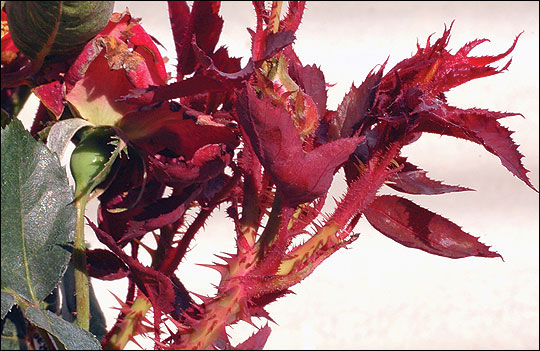 Figure 8
Figure 8
Typical symptoms of rose rosette include malformed growth and a proliferation of thorns.
Rose rosette
Also known as witches'-broom, rose rosette is a relatively new disease caused by a virus-like organism that is spread by a nearly microscopic eriophyid mite. Infection occurs when a mite feeds on an infected plant, then travels to a healthy plant to feed. Early symptoms of rose rosette are rapid stem elongation followed by certain branches of the plant developing thickened, abnormally thorny stems. Then, many short deformed shoots form, often displaying a red pigmentation and smaller, misshapen leaves. Plants usually die within a year or two as the disease spreads. The virus can infect any species of the genus Rosa and can devastate rose plantings. Currently, there is no control for this disease; the best action is to completely remove and destroy infected plants when symptoms first appear.
Brown canker
Canker usually is less serious than black spot or powdery mildew, but it is very destructive. Infection may take place in summer. In late winter or early spring, small purple-tinged or white spots develop into large brown patches. Infected canes may grow poorly or die. Best control is to cut out infected canes well below the lowest point of infection.
Other diseases
Other rose diseases include rust, crown gall, anthracnose and petal blight. These are generally less common, however, than the four described above.
Disease resistance
All classes of roses are susceptible to black spot to varying degrees. Hybrid teas, grandiflora, floribunda and polyanthas all are quite susceptible. Varieties containing some R. wichuraiana and R. rugosa ancestry are more resistant. However, there are varietal differences as well. Yellow hybrid teas are generally more susceptible to black spot than the other colors.
Susceptibility to powdery mildew also differs between rose species and cultivars. In general, roses with very waxy leaves, such as R. rugosa, have a fairly high degree of mildew resistance.
In general, many species of shrub and old garden roses have greater disease resistance than the new hybrid teas and their relatives. Therefore, where a lower maintenance rose garden is wanted and where mass effect is more important than flower form, these types should be selected.
Insects
Aphid
Aphids are the most common insect pests of roses. Sometimes called plant lice, aphids are soft-bodied green, brown or reddish insects that can be identified by the two structures called cornicles protruding from their abdomen. They are usually abundant in soft growing tips and on the stem just below the flower buds. Severe infestations may deform the leaves, stems or buds.
Several effective insecticides are available for aphid control. Begin sprays as soon as aphids are noticed in early spring. Summer infestations are usually not severe if spring control was achieved.
Spider mite
Spider mites are very small pests more closely related to spiders than to insects. Because of their small size, they often go undetected until significant populations have developed. At that time, tiny webs between and on the lower sides of leaves indicate their presence. As spider mites feed, leaves become yellowish and finally brown. They are most serious in hot, dry weather.
When spiders mites are present, a miticide labeled for roses must be used frequently. In severe infestations, spraying about every four days will be necessary to control the pest. Damage can be reduced by spraying the plants daily with a strong stream of water to wash some of the mites off the leaves.
Other insect pests
Additionally, many leaf- or flower-chewing insects attack roses. They are easily identified by their damage, which occurs as holes and cuts in leaves or petals. Generally, these are not a serious problem and, where they occur, can be easily controlled by using an appropriate insecticide labeled for the pest in question.
Original author
Ray R. Rothenberger, Department of Horticulture